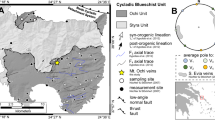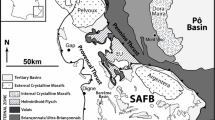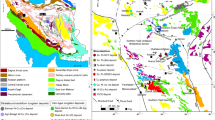Abstract.
Metabasites in the high-pressure unit of the southern Dabie Shan (eastern China) contain quartz veins with high-pressure mineral assemblages. Two veins with the parageneses quartz–paragonite–ankerite–rutile and quartz–kyanite–talc–zoisite–rutile–calcite (pseudomorph after aragonite) as well as quartz–kyanite–paragonite–garnet–omphacite were investigated in detail. Host rocks of these veins are garnet amphibolites with eclogitic relics and quartz eclogites, respectively. The oldest phase of deformation (D1) is recorded in the eclogite, which displays a schistosity with shape alignment of high-pressure minerals such as omphacite, phengite and garnet. An estimate of the metamorphic P–T conditions yields 19–21 kbar at 570–620 °C for the eclogites. Fluid inclusion studies reveal a primary, low-salinity aqueous fluid phase responsible for the formation of the quartz veins. This is in correspondence with calculations of phase equilibrium curves on minerals of the vein paragenesis, which yield P–T conditions of 19.4 kbar and 591 °C in the presence of an aqueous fluid phase. Geochronology using the U–Pb system of rutile gives evidence for a Triassic minimum age of 207–221 Ma for the vein formation, which fits in the geotectonic framework of the orogen. This rather wide age range arises from the heterogeneous nature of the initial lead isotopic composition, reflecting the heterogeneous sources of the lead and the fluid phase. Part of the fluid was probably generated by prograde dehydration reactions in the country rocks of the veins, whereas strong evidence is also given for the derivation from an older basement, which also underwent subduction. The veins may have formed by extensive hydraulic fracturing or by volume reduction during eclogitisation of the crust. Subsequent to the formation of the veins, great parts of the high-pressure rocks experienced an intensive, syn-tectonic (D2) amphibolite facies metamorphism at 8.5–10.5 kbar and 590–645 °C, indicating isothermal decompression during exhumation. In the course of this exhumation, pseudosecondary CO2 inclusions were trapped in quartz of the veins. The last recorded stage of the retrograde overprint took place under static, greenschist facies conditions (450–480 °C) in the stability field of kyanite. The shape of the metamorphic P–T path for this stage is reflected by the fluid phase, which either re-equilibrated during this event or penetrated the rock on fractures. These findings show that fluid flow during subduction-related high-pressure metamorphism and subsequent uplift is rather complex; the fluid phase may originate from different sources and may interact with country rocks in the form of a chromatographic column transforming mineral assemblages, and also changing its own character.
Similar content being viewed by others
Author information
Authors and Affiliations
Additional information
Electronic Publication
Rights and permissions
About this article
Cite this article
, ., , ., , . et al. Eclogite-facies quartz veins within metabasites of the Dabie Shan (eastern China): pressure–temperature–time–deformation path, composition of the fluid phase and fluid flow during exhumation of high-pressure rocks. Contrib Mineral Petrol 141, 322–346 (2001). https://doi.org/10.1007/s004100000233
Received:
Accepted:
Issue Date:
DOI: https://doi.org/10.1007/s004100000233




